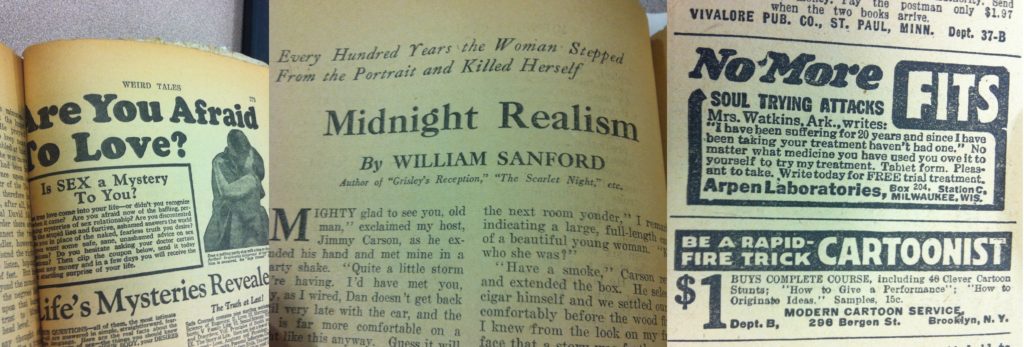
We asked Jade Wallace to tell us a bit about the process of writing their poem “Contretemps,” which appears in issue 58.3 SPRAWL. You can buy the issue or subscribe to read another of Jade’s poems, “Phenomenology of Night,” and other brilliant and sprawling works.
Contretemps
by Jade Wallace
It is hard to believe in
the apocalypse when,
so many times, we have
passed in dread the eve
of our devastation, only
to wake and find that we
must still fulfill our dull
obligations. The narcissist
in me, anguished and myopic,
longs for a waning world’s
saturnine symmetry to
complete the lyric lunar
phase of a girl. I think
I might relax at the close
of known life, see death
as letup, end to soul-trying
attacks. Are you and I of
a kind in this? Most at ease
reclining in the arms of those
who are dying as the sun burns
to dust and the world elapses
because, at last, not one
thing can be asked of us.
“Contretemps” has had a complicated life. I could probably trace its origin to the new millennium, when I was a child becoming aware of the concept of apocalypse and its implications for humanity. But I’m no Proust, so let’s skip forward to the winter of 2019. My partner goaded me into going to the Lillian H. Smith Library in Toronto. The library is known for two things: kids’ books and the Merril Collection of Science Fiction, Speculation & Fantasy. The Merril collection houses many interesting relics, one of which is Weird Tales, a fantasy and horror pulp magazine that originally ran from 1923 to 1954. My partner does a lot of collage work and wanted to photograph fonts from the magazine. They won’t actually let you hang out in the archive room, but there is a visitors’ area, where my partner and I sat at a table with a stack of Weird Tales back issues. With little else to do, I impatiently began to read over my partner’s shoulder while he took photos.
I can understand the appeal of collage. You take a bunch of bits you really like and mash them together into, presumably, a thing you like even more. Over my partner’s shoulder, I found myself beginning to photograph titles of stories I thought were poetic (“The Waning of a World,” “Midnight Realism”) and ads that I found perplexing and amusing (“GIRL PHOTOS: Every pose a vision, every vision a perfect dream,” “No more fits, soul-trying attacks”). By the time my partner was ready to go, I had a dozen photos. I wasn’t sure why I had a dozen photos, but I did, indeed, have them.
During the winter of 2019, I worked at a full-time job; the subway commute was prime daydreaming time. I found myself thinking about phrases from Weird Tales often, which is usually a sign that I am going to write about something. I copied down the dozen or so words and phrases I most liked from each of the photos and began arranging and rearranging them in my notebook until I had the blurry outline of a poetic trajectory. When it came to actually writing the poem, I knew I wanted a regulated, but not conventional form. I don’t know why I wanted this. I began with lines of twelve syllables, in which the sixth syllable of an odd-numbered line rhymed or half-rhymed with the twelfth syllable of the subsequent even-numbered line. For example:
a study in midnight realism positing that
impeccability exists in the half-light.
I continued that line pattern until I had three sextains. Here is one of the original versions of the poem, which you’ll note is almost nothing at all like its current iteration:
Have you ever seen a photo of a woman?
Every pose a vision, every vision a dream,
a study in midnight realism positing that
impeccability exists in the half-light.
The waning world offers itself as symmetry
to complete the lyric lunar phase of a girl.
Does love make you afraid? Is sex a mystery?
You doubt me when I say that both are sweet to take.
They can be instances of honeyed melody,
I swear, requiring little but that you listen.
Sometimes, their swings relax me enough to foresee
a future without fits or soul-trying attacks.
You are alarmed to see a photo of a woman,
unable to love sex disengaged from secrecy.
You and I are alike in that way, most at ease
reposing in the half-seen arms of the dying
as the sun burns to dust and the world elapses
because, at last, not one thing can be asked of us.
I offer you this not because I think it’s any good—actually I cringe rereading it—but so that you may have a brief laugh at my expense and also remember how utterly essential editing is. At that point, I was unhappy with the poem. I liked the barely-noticeable regular metre and rhyme scheme and a few select lines and that was all. I asked a trusted friend to read it, hoping that it was secretly brilliant, unbeknownst to me. It was not.
My friend and I agreed that the whole second stanza seemed digressive and that most of the questions either made no sense or didn’t need to be questions. I reread the poem trying to see what content I actually wanted to keep from it. In the end, the only idea I found interesting was the thematic thread related to the waning world, the elapsing world—in other words, the apocalypse.
Many of the feelings about apocalypse that have been coalescing in me since childhood are ambivalent: I dread it but also wish it would just get itself over it; I resent it yet its threat does justify my persistent sense of melancholy and meaninglessness; I never want other people to suffer but I want to see an end to the suffering we unnecessarily cause. I kept the original poem’s basic structure of rhythm and rhyme but eschewed stanzas, shortened the lines, and articulated my least condonable feelings about the end of days. There was little left of Weird Tales in it. When I finally felt it was done, I almost did not send it out for publication. What good could anyone think of a person who half-wishes for annihilation? I wondered. The feelings expressed in the poem were neither resolved, nor morally wise, nor, I came to suspect, particular to me. The problems at the crux of “Contretemps” were beyond me, in multiple senses. So I sent the poem out, another dispatch to the waning world.

Jade Wallace’s poetry and fiction have appeared in Room Magazine, Vallum Magazine, The Dalhousie Review, Studies in Social Justice, and elsewhere. Their most recent solo chapbook is “Rituals of Parsing” (Anstruther Press 2018) and their most recent collaborative chapbook is “Test Centre” (ZED Press 2019). They are an organizing member of Draft Reading Series and one half of the collaborative writing partnership MA|DE.